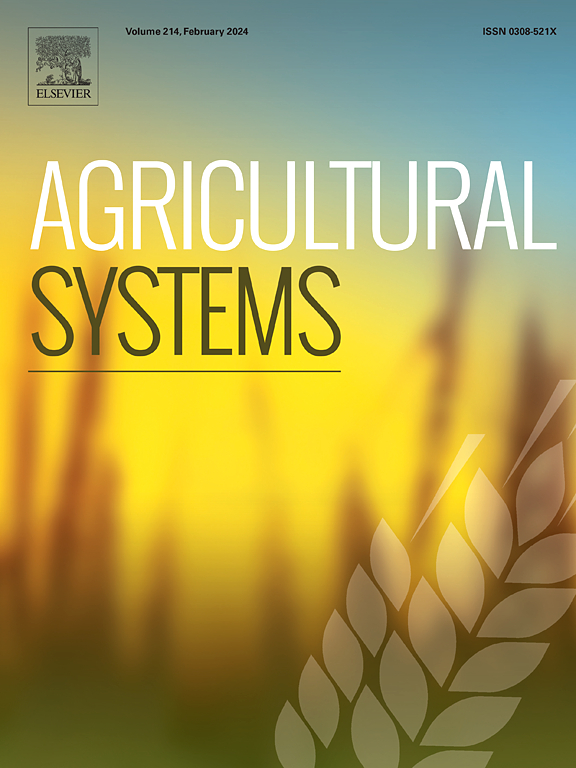释放谷子潜力:中国边际地扩大种植的空间策略与多重效益
IF 6.1
1区 农林科学
Q1 AGRICULTURE, MULTIDISCIPLINARY
引用次数: 0
摘要
在健康中国战略的背景下,粗粮的营养价值越来越受到重视。然而,目前谷子的产量不足,缺乏空间规划,无法满足《中国居民膳食指南》中提出的消费需求。目的通过扩大边际土地产量,优化谷子种植,保障粮食安全,同时应对农业转型,提高公众健康水平。方法利用GAEZ模型对2000 - 2020年中国谷子产量的时空变化进行分析,并对其生产潜力进行估算。利用多元数据对模型结果进行筛选,确定谷子适宜种植区域。结果与结论分析表明,中国谷子种植在空间上主要集中在河北、山西、内蒙古东部和东北省份。研究区谷子潜在种植面积238万公顷,产量992万吨,可满足《中国居民膳食指南》规定的膳食消费需求。与种植玉米相比,利用边际土地种植谷子可以节约50%的水和60%以上的肥料,同时为农民创造约290亿元的收入。意义本研究突出了谷子在减轻水土资源负担、促进健康、增加农民收入等方面的多重效益。研究结果为优化粗粮生产和合理利用边际土地资源提供了明确的空间解决方案。本文章由计算机程序翻译,如有差异,请以英文原文为准。

Unlocking the potential of foxtail millet: Spatial strategy and multiple benefits of expanding cultivation on marginal lands in China
CONTEXT
In the context of Healthy China strategy, nutritious coarse grains are gaining more and more recognition. However, the current production of foxtail millet is insufficient and lack of spatial planning to meet the consumption demands outlined in the Dietary Guidelines for Chinese Residents.
OBJECTIVE
This study aims to optimize foxtail millet cultivation by expanding production on marginal lands, ensuring staple food security while addressing agricultural transformation and improving public health in China.
METHODS
We analyzed the spatiotemporal changes in foxtail millet production in China from 2000 to 2020, using the GAEZ model to estimate its production potential. The model result was filtered using multivariate data to identify suitable regions for foxtail millet cultivation.
RESULTS AND CONCLUSIONS
The analysis revealed that foxtail millet cultivation is spatially concentrated in Hebei, Shanxi, eastern Inner Mongolia, and the northeastern provinces. The potential planting area for foxtail millet is 2.38 million hectares, capable of producing 9.92 million tons in the study area, which can meet dietary consumption needs according to Dietary Guidelines for Chinese Residents. Utilizing marginal lands for foxtail millet cultivation could save 50 % of water and more than 60 % of fertilizer compared to maize, while generating approximately ¥29 billion in revenue for farmers.
SIGNIFICANCE
This study highlights the multiple benefits of foxtail millet in reducing land and water resources burden, promoting health, and increasing farmers' income. The findings provide spatially explicit solutions for optimizing coarse grain production and reasonable utilizing marginal land resources.
求助全文
通过发布文献求助,成功后即可免费获取论文全文。
去求助
来源期刊

Agricultural Systems
农林科学-农业综合
CiteScore
13.30
自引率
7.60%
发文量
174
审稿时长
30 days
期刊介绍:
Agricultural Systems is an international journal that deals with interactions - among the components of agricultural systems, among hierarchical levels of agricultural systems, between agricultural and other land use systems, and between agricultural systems and their natural, social and economic environments.
The scope includes the development and application of systems analysis methodologies in the following areas:
Systems approaches in the sustainable intensification of agriculture; pathways for sustainable intensification; crop-livestock integration; farm-level resource allocation; quantification of benefits and trade-offs at farm to landscape levels; integrative, participatory and dynamic modelling approaches for qualitative and quantitative assessments of agricultural systems and decision making;
The interactions between agricultural and non-agricultural landscapes; the multiple services of agricultural systems; food security and the environment;
Global change and adaptation science; transformational adaptations as driven by changes in climate, policy, values and attitudes influencing the design of farming systems;
Development and application of farming systems design tools and methods for impact, scenario and case study analysis; managing the complexities of dynamic agricultural systems; innovation systems and multi stakeholder arrangements that support or promote change and (or) inform policy decisions.
 求助内容:
求助内容: 应助结果提醒方式:
应助结果提醒方式:


